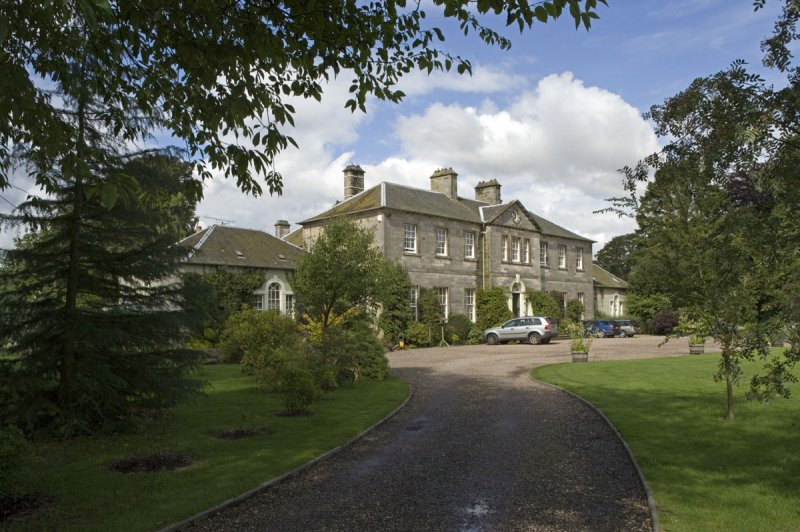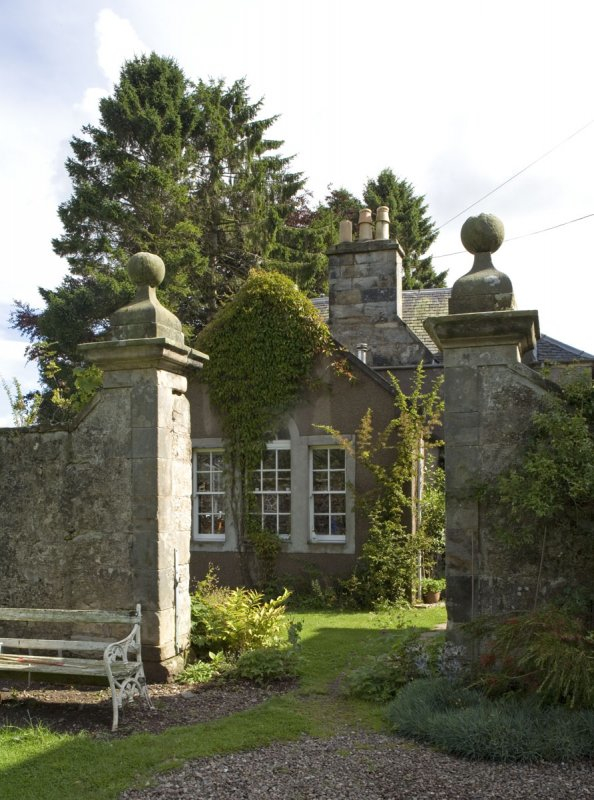
PATRICK DE OGGILUILL (Ogilvy), who about 1267 is witness to a mortification
by Roger de Quincy, Earl of Winchester, for the souls of his wife and
himself, of the church of Lathrisk, with the chapel of Kettle, to the Priory
of St. Andrews. Patrick de Eggilvyn signs as oath of fealty to King Edward
I. on 15 July 1296, and renews his homage with the other magnates of
Scotland at Berwick-on-Tween 28 August, and on 1 September 1305 was a member
of the Inquisition held at Perth to examine into the circumstances under
which Michael de Miggel was in the company with Sir William Wallace.
Lathrisk House, is the seat of the estate, in W. of
Kettle par., Fife, 1½ mile NE. of Falkland. The village of
Kettle was the property of a great number of small feuars; and the lands of
Kettle in more recent times became the property of the Rev. David Symers,
minister of the parish of Kettins in Forfarshire. West of the village is
Orkie Mill and lands, which belonged to James Thompson, Esq.; and Orkie, the
property of the trustees of the endowed school at Drumeldrie. West of Orkie
was Riggs, the later property of Mr James Swan; and at the western end of
the parish Lathrisk, the property was of
William Johnston, Esq., of Lathrisk, which of
old belonged to a family of the same name. Previous to the Johnstone's
however, the Seton family owned all of the lands of Lathrisk for over 8
generations, until dispossessed by their forfeiture of 1716. The
first Seton of Lathrisk was John Seton, descended from the Seton's of
Parbroath, who married Janet Lathrisk of that
Ilk and with her acquired these lands and those of Balbirnie which remained
with their descendants until almost the middle of 18th century.
The ancient name of this parish was "Lathrisk"
as it is sometimes spelled in old charters, "Lorresk," but pronounced "Larisse".
The parish of Kettle was from the circumstances of the parish-church being
formerly situated on the lands of Lathrisk associated with the estate of
that name at the west end of the parish. The church, manse, and glebe,
having been removed about 1636 to the village of Kettle, the parish has from
that time received the name of the village. In old deed the name of the
village is sometimes written Catul, sometimes Katul. In consequence of that
portion of the lands of Kettle on which the village is situated having
belonged anciently to the Crown, the village as well as the parish is called
Kingskettle. The ancient shurch was a vicarage belonging to the priory of
St. Andrews; and there were two chapels, respectively at Chapel and at
Clatto.
The Legend of Clatto: On the
lands of Clatto, at the southeastern extremity of the parish, there are
remains of an old tower which is said to have anciently belonged to the
family Seton, cadets of the Parbroath family, of whom tradition says that
they were notorious robbers and murderers. The old road from Cupar to
Kingshorn passed through Clatto-den; and in the face of the hill, which
forms its boundary, there is alleged to be a cave, which communicated to the
tower of Clatto and had another opening to the road, from which the bandits
rushed out of the unsuspecting passengers, and dragging them into the caves,
robbed and murdered them. Clatto was the castle of the Setons from the
1400's to 1510.
This branch of the Seton
family were all executed by James IV for their crimes, noting the story as:
"The old road from Cupar to Kinghorn passed through Clatto den, and in
the face of the hill, which forms its boundary, there is alleged to be a
cave, which communicated with the tower of Clatto, and had another opening
to the road, from which the Clatto-Setons rushed out upon the unsuspecting
passengers, who had occasion to pass along the road, and dragging them into
the cave, robbed and murdered them. The following is the traditional
account of the discovery and punishment of these assassins. " ... James IV.,
having the occasion of passing that way alone, was attacked by a son of the
laird of Clatto ; but the king immediately drew his sword, and with one blow
cut off the right hand of the robber, with which he had seized hold of the
bridle of the king's horse. The robber on this made his escape, and the king
having taken possession of the hand, rode off.
Next day, attended by a proper retinue, his majesty visited the tower
of Clatto, wishing to see Seton and his sons, who were noted as hardy
enterprising men. The old man conducted his family into the presence
of the king, but it was observed that one of the sons was absent. He,
it was alleged, had been hurt by an accident, and was confined to bed.
The king insisted on seeing him, and desired to feel his pulse. The young
man held out his left hand, but his majesty requested to have the right.
After many excuses, the robber was obliged to confess that he had lost his
right hand. The king then told him that he had a hand, which was at
his service if it fitted him ; and the gory hand of the robber was produced.
The king explained how it came into his possession, and the culprit's guilt
was evident. The whole family were thereupon, it is said, apprehended,
tried, and executed, for the various robberies and murders they had
committed." Such is the tradition as to the castle and den of Clatto;
but it is necessary to mention that there is now no appearance of the cave,
all trace of it having been obliterated " by the breaking down of the banks"
of the den at this place. "
The mansion of Lathrisk House dates from several
periods: the older parts from the 16th century, where what remains
consisting of three adjoining barrel vaults, with walls 5ft thick. The front
wing was added in 1783 (M L Pattullo, owner, Lathrisk House), and
the most recent work nearly 200 years old, in Kettle parish, Fife, near the
right bank of the Eden, 1¾ mile NE of Falkland. Purchased by his
ancestor about 1783, the estate is the property of George Johnstone, Esq.,
who holds 10,005 acres in Fife and 3631 in Perthshire, valued at £14,017 and
£1410 per annum.—Ord. Sur., sh. 40, 1867.
The exterior has been harled, and presents no
obvious datable architectural features. The vaults are as described by OS
(DS). The house/mansion, has been greatly modernised beginning with
the Johnstone tenure of 1783 to 1914, after which it has gone through a
sucession of owners and changes. The only features of interest
remaining from the original house or castle being the parallel vaulted
chambers on the ground floor. The historian Sibbald refers to its existence
in 1710; where the old house with gardens and enclosures, the then seat of
Mr Patrick Seaton, a cadet of the Earl of Winton, and who's predecessor of
his got these lands by marrying the heiress, of the same name with the
lands, Lathrisk; was so noted.
There
is a CONFIRMATION CHARTER by John
Seytoun of
Lauthrisk Wester in favour of Andrew
Seytoun his brother german of a charter by his former tenant David
Lauthrisk of Orkye granting the quarter part of the lands of Easter
Lauthrisk called Langflett dated at Orkye 4 January 1576. Witnesses:
George
Seytoun, James
Seytoun, James Andersoun and Patrick Glasfurd, notary. Faulkland, 12
July 1589. Witnesses: Andrew
Seytoun, brother to granter, Alexander Spens son to the laird of
Lauthallan, Patrick
Seytoun, uncle to the granter and Alexander Fairny, notary.
Likewise there is Papal Bull concerning John Seytoun of
Lauthrisk St Peters, Rome, 9 Nov. 16th year of Pope Paul.
The oft-mentioned dedication of
the medieval church of Leuchars to St Athernase is
actually an error. It arises from a
nineteenth-century misreading of a list of church
dedications in the Register of St Andrews Priory, a
medieval manuscript now in the National Archives of
Scotland. Folio 155v. has a list of churches
dedicated, or re-dedicated, by bishop David de
Bernham of St Andrews in the 1240s. The eighth
church in this list is 'ecclesia sancti Johannis
euangeliste et sancti Athernisci confessoris de
Losceresch (the church of St John the evangelist and
St Athernase the confessor). But the church of
Losceresch is not the church of Leuchars, which in
medieval sources is spelt Lochris, Locres etc., but
the parish church of Lathrisk (now Kettle parish in
Fife), whose early spellings are Losresc (1170s),
Loseresch, Losseresc (1227) and such like. Athernase
is the patron saint not of Leuchars but of Lathrisk.
 The last Seton of Lathrisk was
John Seton, inheriting the barren rights from his
father, Patrick Seton, who was attainted and forfeit
for his part in he rebellion of 1715, and from this
time on the family of Seton of Lathrisk begins to
fade.
The last Seton of Lathrisk was
John Seton, inheriting the barren rights from his
father, Patrick Seton, who was attainted and forfeit
for his part in he rebellion of 1715, and from this
time on the family of Seton of Lathrisk begins to
fade.
SETON OF LATHRISK NOTES,
FROM THE SKENE FAMILY OF RUBISLAW PAPERS COLLECTION:
CHARTER by George
Seytoun fear of the lands of the vicarage of
Strathmiglo with consent of John
Seytoun of Pittedy in favour of John
Seytoun,
son of the deceased James
Seytoun brother of the laird of Lathrysk of
the ecclesiastical lands of the vicarage of
Strathmiglo, 1590 [Date and witnesses not filled
in].27. A similar document but in favour of his
paternal uncle Captain Patrick Settone, 1590.
RETOUR before David Weland burgess of Cupar, sheriff
depute of Fife, dated 28 April 1590 of George
Settone to his deceased paternal uncle George
Settone in the ecclesiastical lands of Strathmiglo
excepting the houses and gardens formerly occupied
by Laurence Symsone, John Broun and John Gibson
lying on the west side of the Church.
PRECEPT OF CLARE CONSTAT by John Seytoune free
holder of lands of Wester and Eister
Lauthrisk and Patrick Seytoune fear thereof
in favour of John Seytoune as heir to Captain
Patrick Seytoune his paternal uncle in an annualrent
of 216 merks from the lands of Wester and Eister
Lawthrisk.
INSTRUMENT OF SASINE dated 16 June 1576 in favour of
David Seitoun son of Alexander Seitoun brother
german of John Seitoun, laird of Lawthrisk of an
annualrent of 10 merks out of the lands of
Wodderisbie following on a charter by James
Sandilandis, junior of Sanctmonanis and Elizabeth
Strang his spouse. Witnesses: John Robertsone and
John Ferny in Woddirisbie. Notary: David Donaldson.
CHARTER by James Sandilandis, junior of Sanctmonanis
with consent of Elizabeth Strange his spouse in
favour of David Seitoun, son of Alexander Seitoun
brother german of John Seitoun of Lawthrisk of an
annualrent of 10 merks out of the lands of
Woddirisbie. At Wodderisbie, 10 July 1576.
Witnesses: Thomas Maknewn, armiger, James Braid in
Wodheid, and John Bruce servant to the granter.
 The last Seton of Lathrisk was
John Seton, inheriting the barren rights from his
father, Patrick Seton, who was attainted and forfeit
for his part in he rebellion of 1715, and from this
time on the family of Seton of Lathrisk begins to
fade.
The last Seton of Lathrisk was
John Seton, inheriting the barren rights from his
father, Patrick Seton, who was attainted and forfeit
for his part in he rebellion of 1715, and from this
time on the family of Seton of Lathrisk begins to
fade.

 PATRICK DE OGGILUILL (Ogilvy), who about 1267 is witness to a mortification
by Roger de Quincy, Earl of Winchester, for the souls of his wife and
himself, of the church of Lathrisk, with the chapel of Kettle, to the Priory
of St. Andrews. Patrick de Eggilvyn signs as oath of fealty to King Edward
I. on 15 July 1296, and renews his homage with the other magnates of
Scotland at Berwick-on-Tween 28 August, and on 1 September 1305 was a member
of the Inquisition held at Perth to examine into the circumstances under
which Michael de Miggel was in the company with Sir William Wallace.
PATRICK DE OGGILUILL (Ogilvy), who about 1267 is witness to a mortification
by Roger de Quincy, Earl of Winchester, for the souls of his wife and
himself, of the church of Lathrisk, with the chapel of Kettle, to the Priory
of St. Andrews. Patrick de Eggilvyn signs as oath of fealty to King Edward
I. on 15 July 1296, and renews his homage with the other magnates of
Scotland at Berwick-on-Tween 28 August, and on 1 September 1305 was a member
of the Inquisition held at Perth to examine into the circumstances under
which Michael de Miggel was in the company with Sir William Wallace.
